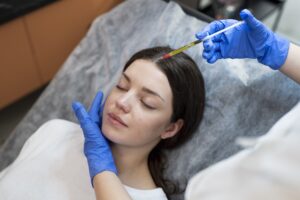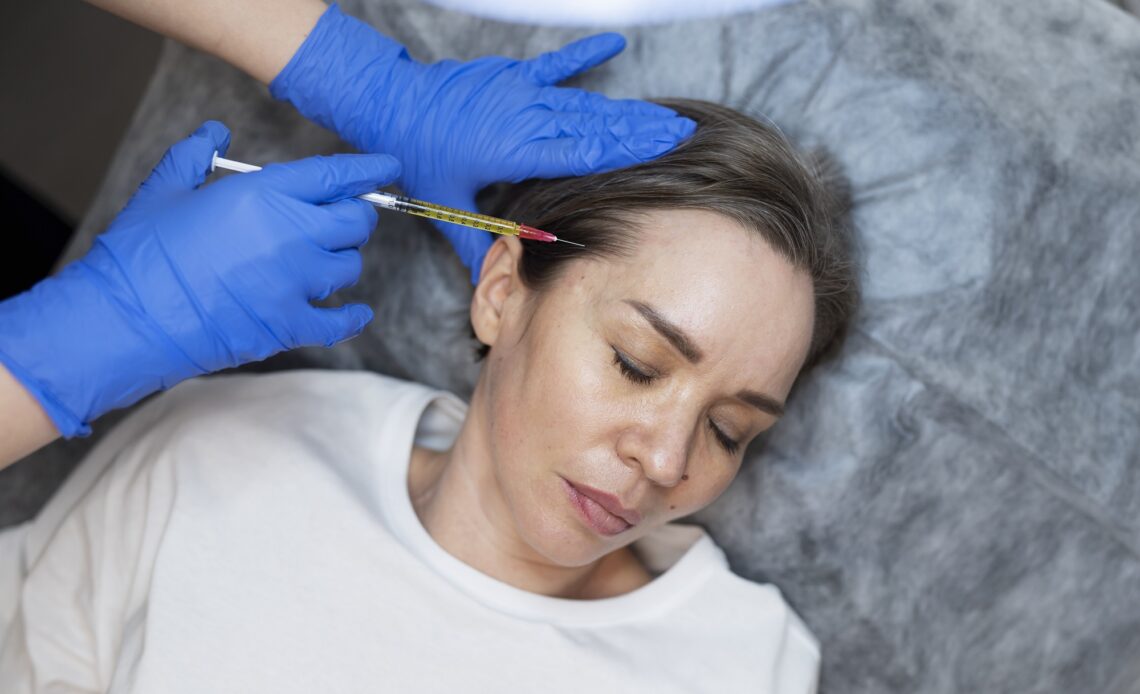Hair loss, a condition that affects millions worldwide, can be a source of significant emotional distress and diminished self-confidence. Whether it’s due to genetics, hormonal imbalances, stress, or medical conditions, the experience of thinning hair or bald patches can be profoundly unsettling. As we navigate through life’s challenges, our hair often serves as a symbol of vitality and youth, and its loss can leave us feeling vulnerable and disconnected from our sense of self. In our pursuit of solutions, we encounter a myriad of products and treatments promising to restore our once-lush locks. However, amidst the sea of options, a revolutionary therapy has emerged, capturing the attention of those seeking a more natural and effective approach to hair restoration – Platelet-Rich Plasma (PRP) therapy for hair loss.
What is Platelet-Rich Plasma (PRP) therapy?
Platelet-Rich Plasma (PRP) therapy is a cutting-edge, minimally invasive treatment that harnesses the power of our body’s own healing mechanisms. Concentrating platelets from a patient’s own blood creates a potent serum rich in growth factors and cytokines. The practitioner then carefully injects this concentrated solution into the scalp, stimulating the hair follicles and promoting new hair growth.

The process begins with a simple blood draw, similar to a routine blood test. A centrifuge spins the collected blood, separating the platelets and plasma from other blood components. The practitioner prepares the concentrated platelet-rich plasma for injection, ensuring a sterile and precise application.
How does PRP therapy promote hair growth?
The efficacy of PRP therapy lies in its ability to kickstart the body’s natural healing processes. When injected into the scalp, the concentrated platelets release a cascade of growth factors and proteins that work in synergy to stimulate hair follicle activity and promote the growth of new, healthy hair strands.
Some of the key mechanisms by which PRP therapy promotes hair growth include:
- Stimulating stem cells: The growth factors present in PRP activate dormant hair follicle stem cells, encouraging them to enter the active growth phase (anagen) and produce new hair strands.
- Increasing blood supply: PRP enhances the proliferation of new blood vessels (angiogenesis) in the scalp, ensuring an adequate supply of nutrients and oxygen to the hair follicles.
- Reducing inflammation: The anti-inflammatory properties of PRP help to create a favorable environment for hair growth by reducing inflammation in the scalp, which can contribute to hair loss.
- Prolonging the growth phase: Studies show that PRP extends the anagen (growth) phase of the hair cycle, allowing hair strands to grow longer before entering the resting or shedding phase.
Benefits of PRP therapy for hair loss
PRP therapy offers a multitude of benefits for individuals struggling with hair loss, making it an attractive option for those seeking a natural and effective solution. Here are some of the key advantages of this innovative treatment:

- Minimal invasiveness: Unlike surgical hair transplantation procedures, PRP therapy is a minimally invasive treatment that involves simple injections into the scalp, reducing the risk of complications and downtime.
- Natural approach: PRP therapy utilizes the patient’s own blood, eliminating the risk of allergic reactions or rejections associated with synthetic or foreign substances.
- Stimulates hair growth: By activating dormant hair follicles and promoting the growth of new, healthy hair strands, PRP therapy can effectively address various forms of hair loss.
- Long-lasting results: While the duration of results may vary from individual to individual, many patients report sustained hair growth and improved hair density for several months to years after completing a course of PRP therapy.
- Versatile application: PRP therapy can be used as a standalone treatment or in combination with other hair loss treatments, such as minoxidil or finasteride, potentially enhancing their effectiveness.
- Minimal side effects: Compared to other hair loss treatments, PRP therapy has a relatively low risk of side effects, as it utilizes the patient’s own blood components.
The procedure: What to expect during a PRP session?
Undergoing PRP therapy is a straightforward process that typically involves the following steps:
- Blood draw: The practitioner draws a small amount of blood, typically between 10 and 60 ml, from the patient’s arm, similar to a routine blood test.
- Centrifugation: The collected blood is placed in a centrifuge, where it is spun at high speeds to separate the platelets and plasma from other blood components.
- Preparation: The concentrated platelet-rich plasma is carefully extracted and prepared for injection, ensuring sterility and optimal concentration.
- Numbing: To minimize discomfort, a topical anesthetic cream or local anesthetic may be applied to the scalp area before the injections.
- Injections: Using a fine needle, the PRP solution is injected into the scalp at various points, targeting the areas of hair loss or thinning.
- Post-treatment care: After the injections, patients may experience mild swelling, redness, or tenderness in the treated areas, which typically subsides within a few days. Specific post-treatment instructions will be provided to ensure optimal healing and results.
The entire process typically takes between 60 and 90 minutes, and most patients can resume their normal activities immediately after the treatment.
Who is a good candidate for PRP therapy?
While PRP therapy has shown promising results for various types of hair loss, not everyone may be an ideal candidate for this treatment. Generally, individuals who may benefit the most from PRP therapy include:

- Those with androgenetic alopecia (male or female pattern baldness): PRP therapy has been found to be particularly effective in treating this common form of hair loss.
- Individuals with alopecia areata (patchy hair loss): PRP therapy can help stimulate hair regrowth in areas affected by this autoimmune condition.
- Patients experiencing telogen effluvium (excessive shedding): PRP therapy can help stabilize the hair cycle and promote new hair growth.
- Individuals with thinning hair or poor hair density: PRP therapy can help improve overall hair density and thickness.
- Those seeking a minimally invasive and natural approach to hair restoration: PRP therapy offers a non-surgical and autologous (using the patient’s own blood) solution for hair loss.
It’s important to note that individuals with certain medical conditions, such as bleeding disorders or active skin infections, may not be suitable candidates for PRP therapy. A thorough consultation with a qualified healthcare provider is essential to determine eligibility and suitability for this treatment.
Potential side effects and risks of PRP therapy
Although most consider PRP therapy safe and well-tolerated, patients should be aware of potential side effects and risks, as with any medical procedure. These may include:
- Injection site reactions: Some patients may experience mild swelling, redness, or tenderness at the injection sites, which typically resolves within a few days.
- Bruising or bleeding: As PRP therapy involves injections, there is a small risk of bruising or minor bleeding at the injection sites.
- Infection: Although rare, there is a slight risk of infection if proper sterile techniques are not followed during the procedure.
- Headaches or dizziness: Some individuals may experience temporary headaches or dizziness after the treatment, likely due to the injection process or the release of growth factors.
- Allergic reactions: While extremely rare, some individuals may have an allergic reaction to components within their own blood or the materials used during the procedure.
It’s crucial to discuss any concerns or potential risks with a qualified healthcare provider before undergoing PRP therapy. Additionally, following post-treatment instructions carefully can help minimize the risk of complications and ensure optimal results.
Finding a reputable PRP therapy provider
While the success of PRP therapy largely depends on individual factors, choosing a reputable and experienced provider is crucial for achieving optimal results and minimizing potential risks. Here are some tips to help you find a qualified PRP therapy provider:

- Look for board-certified dermatologists or plastic surgeons: These medical professionals have extensive training and experience in hair restoration techniques, including PRP therapy.
- Check credentials and experience: Inquire about the provider’s credentials, training, and experience in performing PRP therapy for hair loss. A reputable provider should be able to provide detailed information about their expertise and success rates.
- Read reviews and testimonials: Online reviews and testimonials from previous patients can provide valuable insights into the provider’s professionalism, bedside manner, and the quality of their services.
- Inquire about the specific PRP protocol: Different providers may use varying techniques and protocols for PRP therapy. Understand the provider’s approach, including the centrifugation process, injection techniques, and the number of recommended sessions.
- Consider the facility and equipment: Look for providers who operate in clean, professional, and well-equipped facilities, ensuring sterile conditions and proper handling of blood products.
- Discuss costs and payment options: PRP therapy can be an investment, so it’s essential to understand the associated costs and any available payment plans or financing options.
By taking the time to research and choose a qualified and experienced PRP therapy provider, you can increase your chances of achieving successful results and a positive overall experience.
Conclusion
While the success of PRP therapy may vary from individual to individual, the growing body of research and countless success stories highlight its potential as a viable option for those seeking to regain their hair’s fullness and vitality. However, it’s essential to approach this treatment with realistic expectations and under the guidance of a qualified and experienced healthcare provider.
As with any medical procedure, it’s crucial to weigh the potential benefits against the risks and to have an open dialogue with your healthcare provider about your specific needs and concerns. By doing so, you can make an informed decision and embark on a journey towards restoring your confidence and embracing a revitalized sense of self.


